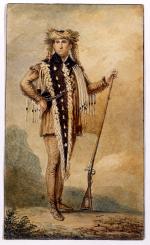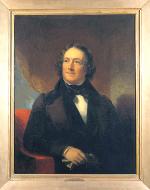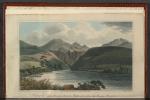Chapter Three: Documenting the Expedition
Thomas Jefferson expected Lewis and Clark's Expedition to last eighteen months - two years at the most. But after the volunteers set off down the Ohio River from Pittsburgh on that last day of August 1803, three years came and went before they returned.
By 1806, Meriwether Lewis and William Clark's Corps of Discovery, had crossed the Mississippi, navigated the Great Plains, managed to cross the Rocky Mountains, encountered - and avoided - numerous Native American tribes, and survived a winter on the Pacific coast. And as the summer of 1806 approached, Lewis and Clark were still making their way back East. No one, however, knew where they were. No one had heard from or seen a sign of the Expedition since the keelboat, loaded with specimens and journals, had traveled back down the Missouri River in April of 1805.
Meriwether Lewis and William Clark's Corps of Discovery, had crossed the Mississippi, navigated the Great Plains, managed to cross the Rocky Mountains, encountered - and avoided - numerous Native American tribes, and survived a winter on the Pacific coast. And as the summer of 1806 approached, Lewis and Clark were still making their way back East. No one, however, knew where they were. No one had heard from or seen a sign of the Expedition since the keelboat, loaded with specimens and journals, had traveled back down the Missouri River in April of 1805.
At last, on September 20, 1806, thirty-six months and over 8,000 miles after shoving off down the Ohio River from Pittsburgh, the Corps of Discovery emerged from the Missouri River. Lewis recorded the moment of recognition in the Journals:
Obviously, they were not lost. In reality, everyone had underestimated the duration of the trip. Immediately, newspapers clamored to print first-hand accounts of the Expedition, so great were the international appetites for details of Lewis and Clark's epic adventure. Knowing this, Clark asked Lewis, the better writer of the two, to compose a letter to Clark's brother in Frankfort, Kentucky. Clark copied the letter, signed it, and ferried it across the Mississippi River to a post office in Illinois. On October 11th, the letter was published in Frankfort's Western World. Seventeen days later it appeared in the Pittsburgh Gazette. By November 3rd, only ten days after Jefferson received a letter from Lewis, residents of Washington, D. C. were reading the first account of the compelling frontier adventure in the National Intelligencer.
Public celebrations in honor of the Corps of Discovery soon became a favorite national pastime. The very first toast - at a feast hosted by the Saint Louis town fathers on September 25th - was to President Jefferson, "friend of science, the polar star of discovery, the philosopher and patriot." And Jefferson's own annual message to Congress in December focused on Lewis and Clark. "The Expedition," he stated, "has had all the success which could have been expected."
In December, Lewis finally arrived in Washington and paid a long-awaited visit to the President, who implored him to share what he had seen, heard, and done. As they spoke, Lewis knelt down on the floor of the White House and unfurled Clark's large, manuscript map that depicted the vast expanse of Native American lands that would become known as the American West. The two men got down on their hands and knees to review it, inch by inch. Details about the continent, long governed by myths, were now replaced by facts about the land, its natural history, and its Indian cultures.
Unofficial accounts of the Expedition soon surfaced, including one by Expedition volunteer Patrick Gass and a fictitious account in German, published in
Patrick Gass and a fictitious account in German, published in  Lebanon, Pennsylvania. For Jefferson, new challenges now existed, including how to inspire and fund further exploration and discoveries, and economic development and settlement of the newly charted lands.
Lebanon, Pennsylvania. For Jefferson, new challenges now existed, including how to inspire and fund further exploration and discoveries, and economic development and settlement of the newly charted lands.
To help meet these goals, Jefferson wanted Lewis to compile a full record of the Expedition and its findings to present to the world. Jefferson envisioned a multi-volume publication that would consist of a narrative of the journey and a full account of the scientific and geographic discoveries, illustrated with hand-colored engravings, charts, and maps. Lewis promised the newspapers a book that would "open views of great and immediate objects of national utility."
With his next assignment looming before him, Lewis returned to Philadelphia in April 1807. Exhausted, he spent three months renewing old friendships and making arrangements for publication of the journals. He returned a borrowed book to botanist Benjamin Smith Barton, who agreed to write the scientific volume of the expedition's history, and returned a silent air rifle to Philadelphia inventor Isaiah Lukens.
Benjamin Smith Barton, who agreed to write the scientific volume of the expedition's history, and returned a silent air rifle to Philadelphia inventor Isaiah Lukens.
Elected a member of the American Philosophical Society in absentia, Lewis now attended the Society's meetings as a peer. He sat for a portrait by the great Charles Willson Peale, the man who had painted the heroes of the American Revolution. Lewis gave Peale the elegant Indian tippet he wore for his portrait, an ermine-skin robe given to him by the Shoshone chief Cameahwait. While in Philadelphia, Lewis also commissioned illustrations for his book, and hired a surveyor to check and, if necessary, correct the Expedition's navigational measurements.
Charles Willson Peale, the man who had painted the heroes of the American Revolution. Lewis gave Peale the elegant Indian tippet he wore for his portrait, an ermine-skin robe given to him by the Shoshone chief Cameahwait. While in Philadelphia, Lewis also commissioned illustrations for his book, and hired a surveyor to check and, if necessary, correct the Expedition's navigational measurements.
In 1805, Lewis had sent back two trunks of specimens from the Dakotas that included seeds and plant cuttings which Jefferson had entrusted to Philadelphia horticulturalists Bernard McMahan and William Hamilton, who had grown plants from these specimens on his Woodlands estate. In Philadelphia, McMahon introduced Lewis to botanist Frederick Pursh to help catalogue the more than 200 plant samples he had brought back from the west.
Woodlands estate. In Philadelphia, McMahon introduced Lewis to botanist Frederick Pursh to help catalogue the more than 200 plant samples he had brought back from the west.
Over time, however, the increasingly hectic and complicated demands placed on Lewis following the conclusion of the Expedition began to get the better of him. After Jefferson appointed him governor of Louisiana, Lewis returned to St. Louis where he partied, drank, looked unsuccessfully for a wife, advanced America's-and his own-interests in fur trading with the tribes west of the Mississippi, antagonized his superiors in Washington, and self medicated for his recurring bouts with malaria and fits of depression.
As time passed, he knew that his lack of progress on the expedition's journals was disappointing Jefferson and his Philadelphia mentors. In July 1809, Jefferson demanded "to know when your work will begin to appear." In an uncharacteristically stern letter he wrote to Lewis in August, Jefferson pointed out that he had "so often promised copies to my literary correspondents in France, that I am almost bankrupt in their eyes."
As Lewis' depression grew, so did his debt and his drinking. Adding fuel to the fire, his political enemies accused him of conflicts of interest and abuse of federal funds. Alarmed at his deteriorating political position and finances, Lewis set out from Saint Louis for Washington and Philadelphia to restore his reputation and finally get the journals published. During the trip, however, Lewis' traveling companions became so alarmed by his depression and attempted suicides that they tried to keep his guns away from him. It didn't work. On October 11, 1809, Meriwether Lewis arrived alone at a small inn, some 72 miles west of Nashville, Tennessee. Late that night he shot himself. He died the following morning.
After Lewis' untimely death, Clark had no choice but to pick up the pieces and move forward with the Expedition's official publication. To do so he, too, had to travel to Philadelphia, the nation's cultural, scientific, and publishing capital. Jefferson briefly toyed with the idea of taking over the project, but that would have required the former President to leave his beloved Monticello.
After he arrived in Philadelphia in 1810, Clark agreed to have his portrait painted by Peale, who used the occasion to try to persuade the explorer to accept the responsibilities of author and editor. Convinced that he lacked the writing skills necessary to prepare the manuscript himself, Clark found a new editor in the brilliant and talented Nicholas Biddle. Everyone, it seemed, breathed a sign of relief, expecting that the much-delayed project would at last move to swift completion.
Nicholas Biddle. Everyone, it seemed, breathed a sign of relief, expecting that the much-delayed project would at last move to swift completion.
For the next four long years, scientists and educators, Americans and Europeans waited impatiently for the publication - no one more eagerly than the Expedition's originator and sponsor, Thomas Jefferson. It was not until 1814, however, that The History of the Expedition finally appeared. By then, it had passed through the hands of at least seven writers and two publishers, and taken six more years to write than Jefferson had first envisioned.
When finally published, Jefferson and most others were disappointed in the result. Biddle's polished narrative told an impressively patriotic - and sanitized - story of the expedition. And the large, detailed map was a masterpiece. But Biddle and his successor, Paul Allen, had been unable to find a natural scientist of the stature of Benjamin Smith Barton to sift through and organize Lewis" botanical and zoological discoveries in order to include them in the volumes. These, Jefferson reluctantly admitted, would have to "become known to the world thro" other channels."
By 1806,
At last, on September 20, 1806, thirty-six months and over 8,000 miles after shoving off down the Ohio River from Pittsburgh, the Corps of Discovery emerged from the Missouri River. Lewis recorded the moment of recognition in the Journals:
We came in sight of the little French village of Charriton [La Charette] the men raised a Shout and Sprung upon their ores and we soon landed opposit to the Village. Our party requested to be permitted to fire off their Guns which was alowed and they discharged 3 rounds with a harty cheer, which was returned from five trading boats… every person, both French and Americans seem to express great pleasure at our return, and acknowledged themselves much astonished in seeing us return. They informed us that we were supposed to have been lost long since.
Obviously, they were not lost. In reality, everyone had underestimated the duration of the trip. Immediately, newspapers clamored to print first-hand accounts of the Expedition, so great were the international appetites for details of Lewis and Clark's epic adventure. Knowing this, Clark asked Lewis, the better writer of the two, to compose a letter to Clark's brother in Frankfort, Kentucky. Clark copied the letter, signed it, and ferried it across the Mississippi River to a post office in Illinois. On October 11th, the letter was published in Frankfort's Western World. Seventeen days later it appeared in the Pittsburgh Gazette. By November 3rd, only ten days after Jefferson received a letter from Lewis, residents of Washington, D. C. were reading the first account of the compelling frontier adventure in the National Intelligencer.
Public celebrations in honor of the Corps of Discovery soon became a favorite national pastime. The very first toast - at a feast hosted by the Saint Louis town fathers on September 25th - was to President Jefferson, "friend of science, the polar star of discovery, the philosopher and patriot." And Jefferson's own annual message to Congress in December focused on Lewis and Clark. "The Expedition," he stated, "has had all the success which could have been expected."
In December, Lewis finally arrived in Washington and paid a long-awaited visit to the President, who implored him to share what he had seen, heard, and done. As they spoke, Lewis knelt down on the floor of the White House and unfurled Clark's large, manuscript map that depicted the vast expanse of Native American lands that would become known as the American West. The two men got down on their hands and knees to review it, inch by inch. Details about the continent, long governed by myths, were now replaced by facts about the land, its natural history, and its Indian cultures.
Unofficial accounts of the Expedition soon surfaced, including one by Expedition volunteer
To help meet these goals, Jefferson wanted Lewis to compile a full record of the Expedition and its findings to present to the world. Jefferson envisioned a multi-volume publication that would consist of a narrative of the journey and a full account of the scientific and geographic discoveries, illustrated with hand-colored engravings, charts, and maps. Lewis promised the newspapers a book that would "open views of great and immediate objects of national utility."
With his next assignment looming before him, Lewis returned to Philadelphia in April 1807. Exhausted, he spent three months renewing old friendships and making arrangements for publication of the journals. He returned a borrowed book to botanist
Elected a member of the American Philosophical Society in absentia, Lewis now attended the Society's meetings as a peer. He sat for a portrait by the great
In 1805, Lewis had sent back two trunks of specimens from the Dakotas that included seeds and plant cuttings which Jefferson had entrusted to Philadelphia horticulturalists Bernard McMahan and William Hamilton, who had grown plants from these specimens on his
Over time, however, the increasingly hectic and complicated demands placed on Lewis following the conclusion of the Expedition began to get the better of him. After Jefferson appointed him governor of Louisiana, Lewis returned to St. Louis where he partied, drank, looked unsuccessfully for a wife, advanced America's-and his own-interests in fur trading with the tribes west of the Mississippi, antagonized his superiors in Washington, and self medicated for his recurring bouts with malaria and fits of depression.
As time passed, he knew that his lack of progress on the expedition's journals was disappointing Jefferson and his Philadelphia mentors. In July 1809, Jefferson demanded "to know when your work will begin to appear." In an uncharacteristically stern letter he wrote to Lewis in August, Jefferson pointed out that he had "so often promised copies to my literary correspondents in France, that I am almost bankrupt in their eyes."
As Lewis' depression grew, so did his debt and his drinking. Adding fuel to the fire, his political enemies accused him of conflicts of interest and abuse of federal funds. Alarmed at his deteriorating political position and finances, Lewis set out from Saint Louis for Washington and Philadelphia to restore his reputation and finally get the journals published. During the trip, however, Lewis' traveling companions became so alarmed by his depression and attempted suicides that they tried to keep his guns away from him. It didn't work. On October 11, 1809, Meriwether Lewis arrived alone at a small inn, some 72 miles west of Nashville, Tennessee. Late that night he shot himself. He died the following morning.
After Lewis' untimely death, Clark had no choice but to pick up the pieces and move forward with the Expedition's official publication. To do so he, too, had to travel to Philadelphia, the nation's cultural, scientific, and publishing capital. Jefferson briefly toyed with the idea of taking over the project, but that would have required the former President to leave his beloved Monticello.
After he arrived in Philadelphia in 1810, Clark agreed to have his portrait painted by Peale, who used the occasion to try to persuade the explorer to accept the responsibilities of author and editor. Convinced that he lacked the writing skills necessary to prepare the manuscript himself, Clark found a new editor in the brilliant and talented
For the next four long years, scientists and educators, Americans and Europeans waited impatiently for the publication - no one more eagerly than the Expedition's originator and sponsor, Thomas Jefferson. It was not until 1814, however, that The History of the Expedition finally appeared. By then, it had passed through the hands of at least seven writers and two publishers, and taken six more years to write than Jefferson had first envisioned.
When finally published, Jefferson and most others were disappointed in the result. Biddle's polished narrative told an impressively patriotic - and sanitized - story of the expedition. And the large, detailed map was a masterpiece. But Biddle and his successor, Paul Allen, had been unable to find a natural scientist of the stature of Benjamin Smith Barton to sift through and organize Lewis" botanical and zoological discoveries in order to include them in the volumes. These, Jefferson reluctantly admitted, would have to "become known to the world thro" other channels."


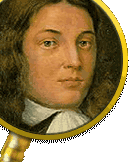





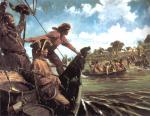
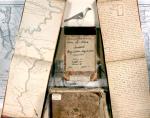

![Frederick Pursh, Mountain Laurel [Plate 14, Catalogue] from Flora Americae Septentrionalis Kalmia Lataforia Frederick Pursh, Mountain Laurel [Plate 14, Catalogue] from Flora Americae Septentrionalis Kalmia Lataforia](cache/small/1-2-27C-25-ExplorePAHistory-a0a9l9-a_349.jpg)
